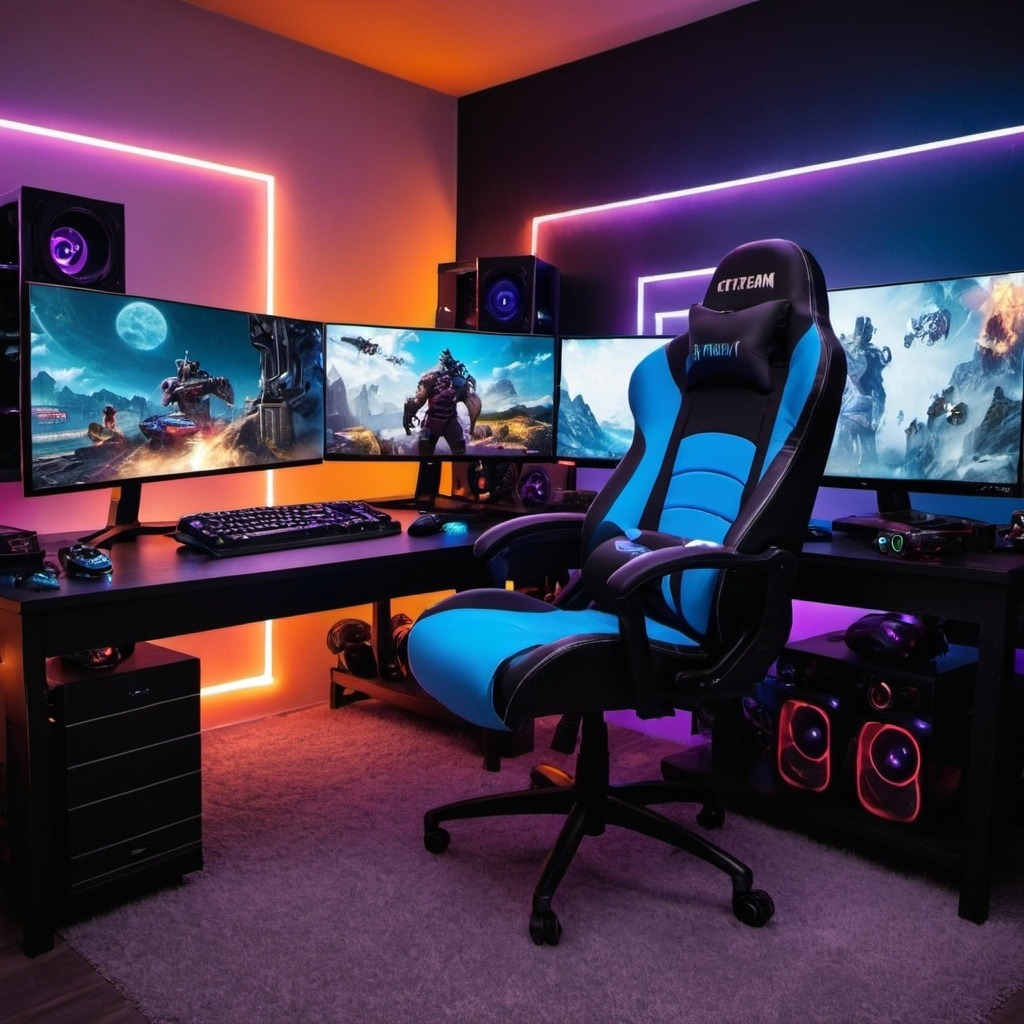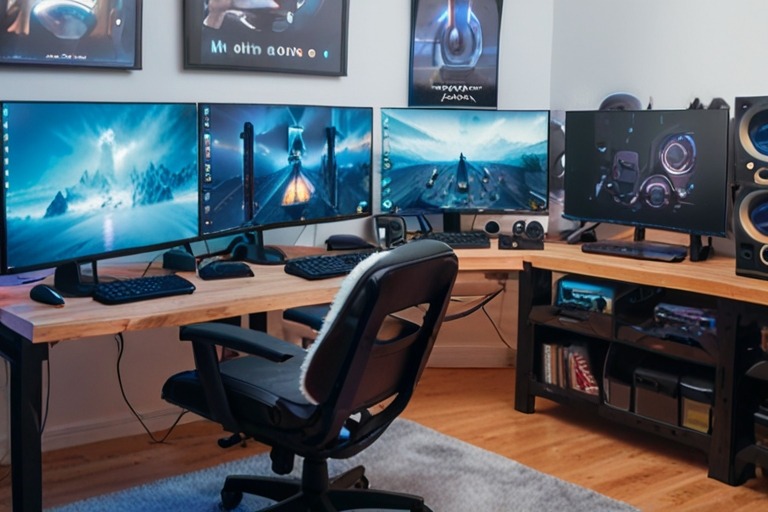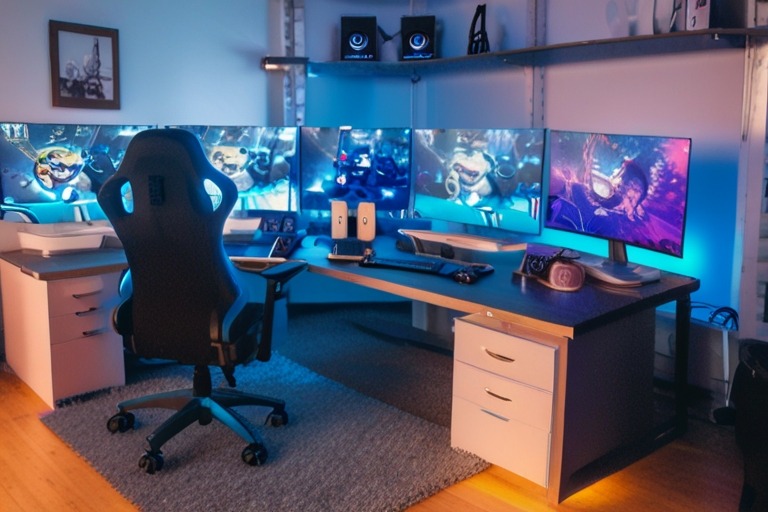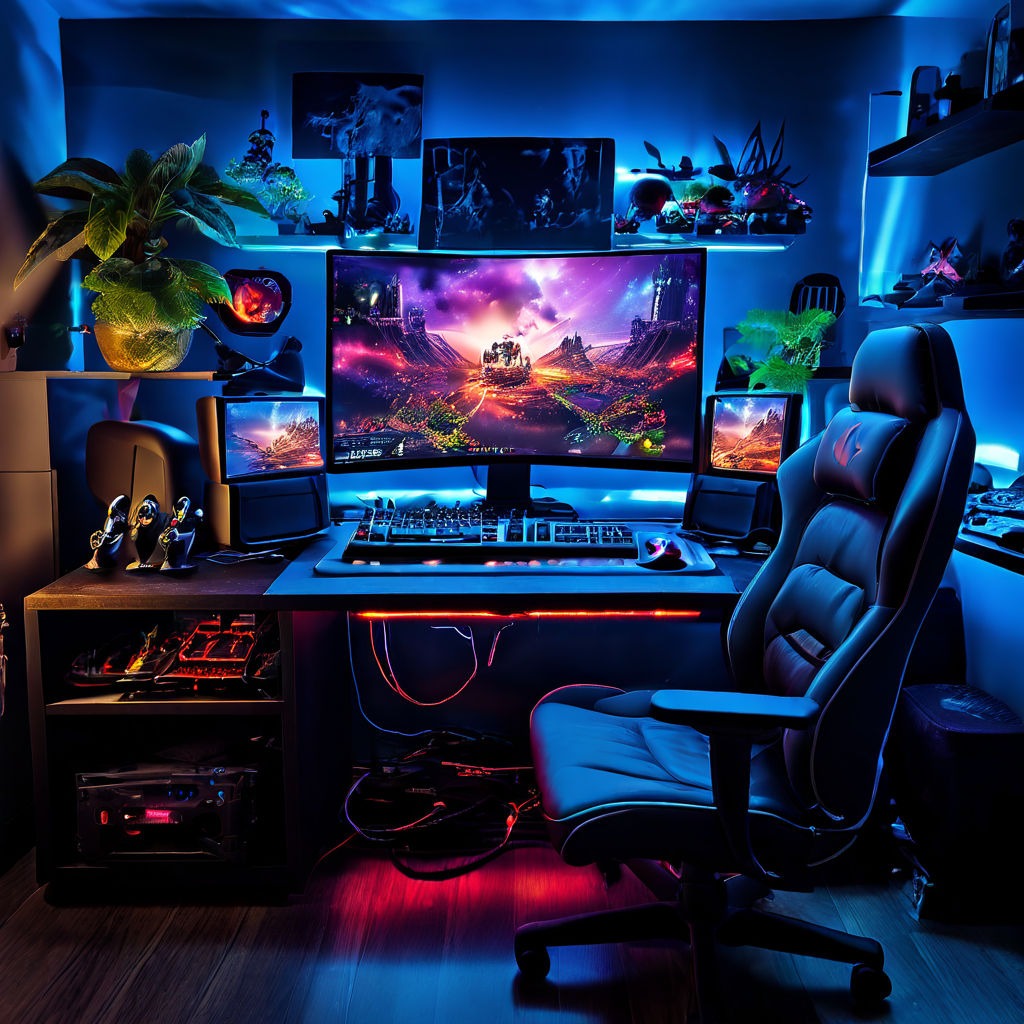
Creating a gaming setup isn’t just about throwing a console on a desk and calling it a day. A well-designed gaming environment can transform your gaming experience, making it more immersive, comfortable, and efficient. Whether you’re a casual gamer or a competitive eSports player, a thoughtfully arranged setup can enhance your performance and enjoyment.
A well-designed gaming setup goes beyond aesthetics; it’s about creating a space that supports your gaming needs and preferences. The right setup can help reduce physical strain, improve focus, and even give you a competitive edge. From the placement of your monitor to the comfort of your chair, each element plays a critical role in shaping your gaming experience.
Benefits of Having an Optimized Gaming Environment
An optimized gaming environment offers numerous benefits that can significantly enhance your gaming sessions. Firstly, it can improve your posture and reduce the risk of physical ailments like back pain and carpal tunnel syndrome. Investing in ergonomic furniture and accessories ensures that you can game for longer periods without discomfort.
Moreover, a well-organized setup minimizes distractions, allowing you to concentrate fully on your game. Good cable management, proper lighting, and an uncluttered space can create a serene environment conducive to better performance. Additionally, having high-quality hardware and peripherals can make your gaming more responsive and visually stunning, providing a more immersive experience.
Lastly, an optimized gaming setup can elevate your overall enjoyment. Personalizing your space with RGB lighting, themed decor, and comfortable seating can make your gaming sessions more enjoyable and satisfying. For more ideas on optimizing your gaming environment.
Assessing Your Space
Creating the perfect gaming setup starts with choosing the right location. The space you select will influence your overall gaming experience, so it’s crucial to make an informed decision.
Determining the Best Location for Your Gaming Setup
When selecting a spot for your gaming setup, consider factors such as natural light, accessibility, and noise levels. A room with minimal external distractions will enhance your focus. Avoid placing your setup near windows to reduce glare on your monitor. If possible, choose a location with good ventilation to prevent overheating your equipment.
Considering Space Requirements and Layout
Understanding your space requirements is essential for creating a functional gaming area. Measure the dimensions of your room and make a list of all the equipment and furniture you plan to include. Consider the size of your gaming desk, chair, and any storage solutions. Ensure there’s enough space for your monitors, keyboard, mouse, and other peripherals without feeling cramped.
Plan your layout by arranging your furniture and equipment in a way that promotes comfort and efficiency. Keep essential items within easy reach and leave enough room for movement. A well-thought-out layout will prevent strain and allow for an enjoyable gaming experience.
Tips for Maximizing Small Spaces
If you’re working with a limited space, there are several strategies you can employ to make the most of it. Opt for compact and multifunctional furniture, such as a desk with built-in storage or a wall-mounted monitor. Utilize vertical space by installing shelves or hooks to store controllers, headphones, and other accessories.
Cable management is especially important in small spaces. Use cable ties or clips to keep cords organized and out of the way. A clean and tidy setup not only looks better but also prevents tripping hazards and makes it easier to move around.
For those who need to game in a shared or multi-purpose room, consider portable or foldable gaming desks and chairs that can be easily stowed away when not in use. This flexibility ensures that your gaming area doesn’t take over your living space.
Maximizing a small space requires creativity and planning, but with the right approach, you can create a functional and enjoyable gaming setup regardless of the size of your room. For more tips on optimizing small spaces
Choosing the Right Hardware
The heart of any gaming setup lies in the hardware. Selecting the right components can make a significant difference in your gaming performance and overall experience. Here’s a guide to help you choose the essential hardware for your ultimate gaming setup.
Essential Components: Gaming PC or Console, Monitors, Peripherals
The first decision you need to make is whether to game on a PC or a console. Each option has its own advantages. Gaming PCs offer more customization, better graphics, and the ability to upgrade components. Consoles, on the other hand, provide a more straightforward setup and often have exclusive game titles.
Once you’ve decided, you’ll need a monitor or TV, peripherals like a keyboard, mouse, controller, and a good headset to complete your setup.
Recommendations for High-Performance Gaming PCs and Consoles
For PC gamers, building a high-performance gaming rig involves choosing the right processor (CPU), graphics card (GPU), and sufficient RAM. Current top-tier CPUs include the AMD Ryzen 9 and Intel Core i9, while leading GPUs are the NVIDIA GeForce RTX 30 series and AMD Radeon RX 6000 series. Aim for at least 16GB of RAM for smooth performance.
For console gamers, the latest models like the PlayStation 5 and Xbox Series X offer powerful performance and excellent graphics. These consoles are designed to deliver seamless gaming experiences with minimal setup.
Selecting Monitors: Size, Resolution, Refresh Rate
Choosing the right monitor is crucial for an immersive gaming experience. Key factors to consider are size, resolution, and refresh rate. Larger screens provide more immersive gameplay, while higher resolutions (like 4K) offer sharper visuals.
For competitive gaming, a high refresh rate (at least 144Hz) and low response time are essential to ensure smooth and responsive gameplay. Monitors like the ASUS ROG Swift and the Alienware AW2521H are excellent choices for high-performance gaming.
Must-Have Peripherals: Keyboard, Mouse, Controller, Headset
The right peripherals can significantly enhance your gaming experience. For PC gamers, a mechanical keyboard with customizable keys and a high-DPI mouse are crucial. Brands like Corsair, Razer, and Logitech offer excellent gaming keyboards and mice.
A good controller is a must for console gamers and can also be beneficial for certain PC games. The Xbox Elite Series 2 and the Dual Sense Wireless Controller for PS5 are top recommendations.
Finally, a high-quality headset is essential for clear communication and immersive sound. Look for headsets with surround sound capabilities and a comfortable fit. Models like the HyperX Cloud II and the Steel Series Arctic 7 are popular among gamers.
Furniture and Ergonomics
Creating a gaming setup isn’t just about the hardware; the right furniture and ergonomics play a critical role in ensuring a comfortable and immersive gaming experience. Here’s how to choose the best furniture and ergonomic accessories for your gaming room.
Importance of a Comfortable Gaming Chair
A comfortable gaming chair is essential for long gaming sessions. Poor seating can lead to back pain, neck strain, and overall discomfort, which can detract from your gaming experience.
Investing in a high-quality gaming chair with ergonomic support helps maintain proper posture and reduces the risk of physical strain. Look for chairs with adjustable height, lumbar support, and a recline function to customize the feel to your needs. Brands like Secretlab and DXRacer offer top-notch gaming chairs designed to provide maximum comfort and support.
Types of Gaming Desks and Their Features
Your gaming desk is the foundation of your setup, providing space for your gaming mouse, keyboard, monitors, and other equipment. The right gaming desk should accommodate all your hardware while offering features that enhance your gaming experience.
Consider desks with adjustable height options, which allow you to switch between sitting and standing positions. L-shaped desks are great for maximizing space in your gaming room, providing ample surface area for multiple monitors and accessories. Some gaming desks come with built-in cable management systems to keep your setup tidy and organized.
Desks like the Arozzi Arena Gaming Desk and the Eureka Ergonomic Gaming Desk offer ample space, durability, and features designed specifically for gamers.
Ergonomic Accessories: Wrist Rests, Monitor Stands, Footrests
Ergonomic accessories can make a significant difference in the comfort and efficiency of your gaming setup. Wrist rests provide support and reduce strain on your wrists, making long hours of using your gaming mouse and keyboard more comfortable. Look for gel-filled or memory foam wrist rests for the best support.
Monitor stands are another essential ergonomic accessory. Elevating your monitors to eye level helps prevent neck strain and promotes better posture. Adjustable monitor stands allow you to find the perfect height and angle for your screens.
Footrests are often overlooked but can enhance your comfort by promoting better circulation and reducing pressure on your lower back. An adjustable footrest with a textured surface can provide additional comfort and stability during intense gaming sessions.
Investing in ergonomic furniture and accessories ensures that your gaming room is not only stylish but also conducive to long, enjoyable gaming sessions. With the right setup, you can enhance your performance, reduce physical strain, and create an inviting space where you love to spend time. For more ideas on gaming furniture and ergonomic solutions.
Lighting and Aesthetics
Lighting and aesthetics play a crucial role in transforming a gaming setup from functional to fantastic. The right lighting can enhance your gaming experience, reduce eye strain, and create an immersive atmosphere. Here’s how to use lighting and decor to take your gaming room to the next level.
Enhancing Your Setup with RGB Lighting
RGB lighting has become a staple in modern gaming setups. These customizable lights can be synchronized with your games, music, or even your mood, adding a dynamic visual element to your gaming environment. RGB lighting strips can be placed behind your monitor, under your desk, or along the edges of your room to create a captivating glow.
Many gaming peripherals, such as keyboards, mice, and headsets, also come with RGB lighting options. These can be coordinated to match the lighting in your room, providing a cohesive and visually stunning setup. Software from brands like Razer, Corsair, and Logitech allows you to customize and synchronize your RGB lighting across all your devices.
Ambient Lighting Options and Placement Tips
In addition to RGB lighting, ambient lighting can significantly enhance your gaming setup. Soft, indirect lighting can reduce eye strain and create a more comfortable gaming environment.
Consider using LED strips, smart bulbs, or floor lamps to achieve the desired effect.
Placement is key to achieving the perfect ambient lighting. Aim to place lights in areas that reduce glare on your screen while providing enough illumination for your gaming area. For example, placing a floor lamp behind your desk can create a pleasant backlighting effect. Smart bulbs that can change color and intensity are a great addition, as they allow you to adjust the lighting to match your mood or the game you’re playing.
Personalizing Your Space with Themed Decor and Accessories

Personalizing your gaming space with themed decor and accessories adds character and makes the area uniquely yours. Start by choosing a theme that reflects your favorite games, characters, or gaming genres. Posters, wall decals, and framed artwork can bring this theme to life.
Consider adding shelves or display cases to showcase collectibles, action figures, or gaming memorabilia. These items not only enhance the aesthetic appeal of your room but also serve as conversation starters and a source of inspiration.
Accessories like custom mousepads, themed cushions, and decorative items can further personalize your space. These small touches can make a big difference in how your gaming room feels and looks. For example, a custom mousepad featuring artwork from your favorite game can add a personal touch to your desk setup.
Incorporating these elements into your gaming room not only enhances its visual appeal but also creates an environment that feels inviting and immersive. By thoughtfully selecting and placing lighting and decor, you can create a gaming setup that is both functional and visually stunning. For more ideas on lighting and decor.
Cable Management and Organization
A clutter-free gaming setup not only looks better but also enhances functionality and ease of use. Effective cable management and organization are essential for maintaining a neat and efficient gaming environment. Here are some techniques, tools, and tips to help you keep your gaming room tidy and organized.
Techniques for Effective Cable Management

Managing cables effectively can transform a chaotic setup into a streamlined and orderly space. Start by planning the placement of your devices and routing the cables accordingly. Use cable ties or Velcro straps to bundle cables together, reducing tangling and making them easier to manage.
Labeling your cables can save time and effort when troubleshooting or making changes to your setup. Color-coded or numbered labels can help you quickly identify which cable belongs to which device.
Consider using cable sleeves or tubing to contain multiple cables, giving them a cleaner appearance and protecting them from damage. Cable clips and mounts can be attached to the back of your desk or along walls to keep cables in place and out of sight.
Tools and Accessories to Keep Your Setup Tidy
Several tools and accessories can help you maintain a tidy gaming setup. Cable management boxes are perfect for hiding power strips and excess cable lengths, keeping them out of view. These boxes come in various sizes and styles to match your decor.
Cable raceways or channels can be mounted along walls or under desks to conceal and route cables neatly. These can be particularly useful for larger setups with multiple devices and long cable runs.
Adhesive cable clips are small but effective tools for securing cables to surfaces and preventing them from dangling or becoming tangled. These clips are versatile and can be used on desks, walls, or the back of furniture.
For wireless peripherals, consider using docking stations or charging hubs to keep your devices organized and charged. These stations often come with built-in cable management features, further reducing clutter.
Tips for Organizing Games, Controllers, and Other Accessories
Keeping your games, controllers, and other accessories organized is key to maintaining an efficient gaming setup. Use storage solutions like shelves, drawers, or dedicated gaming cabinets to store your games and accessories.
Vertical stands or wall mounts can be used to hold controllers and headsets, keeping them within reach and off your desk. Drawer organizers or small storage bins can help you keep smaller accessories, like cables and adapters, neatly sorted.
For game storage, consider using media shelves or a gaming tower that allows you to display and access your collection easily. Grouping games by genre or platform can also make it easier to find the titles you want to play.
If you have a lot of digital games, organizing your digital library is just as important. Use folders and tags on your gaming platform to categorize and quickly access your digital titles.
By implementing these cable management techniques, using the right tools and accessories, and organizing your games and peripherals, you can create a clean, efficient, and visually appealing gaming setup. For more tips on keeping your gaming space organized, check out Wirecutter’s guide.
A well-organized gaming room not only enhances your gaming experience but also makes your setup easier to maintain and enjoy.
